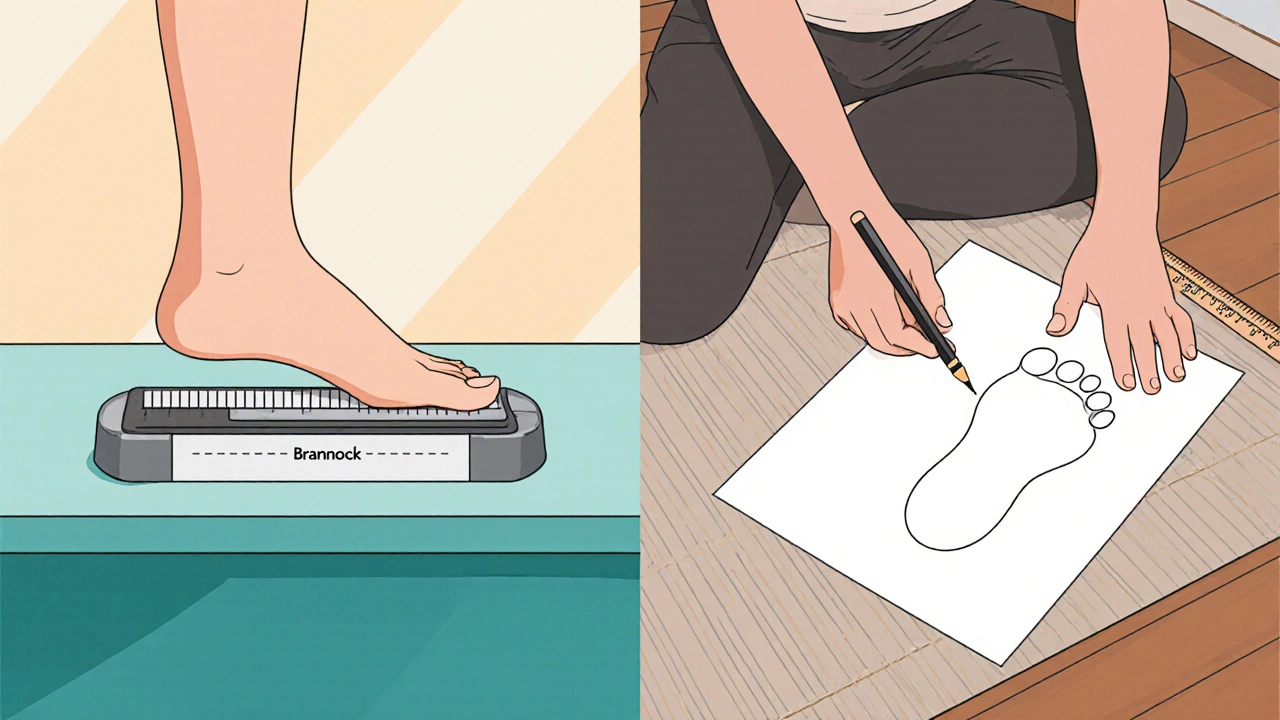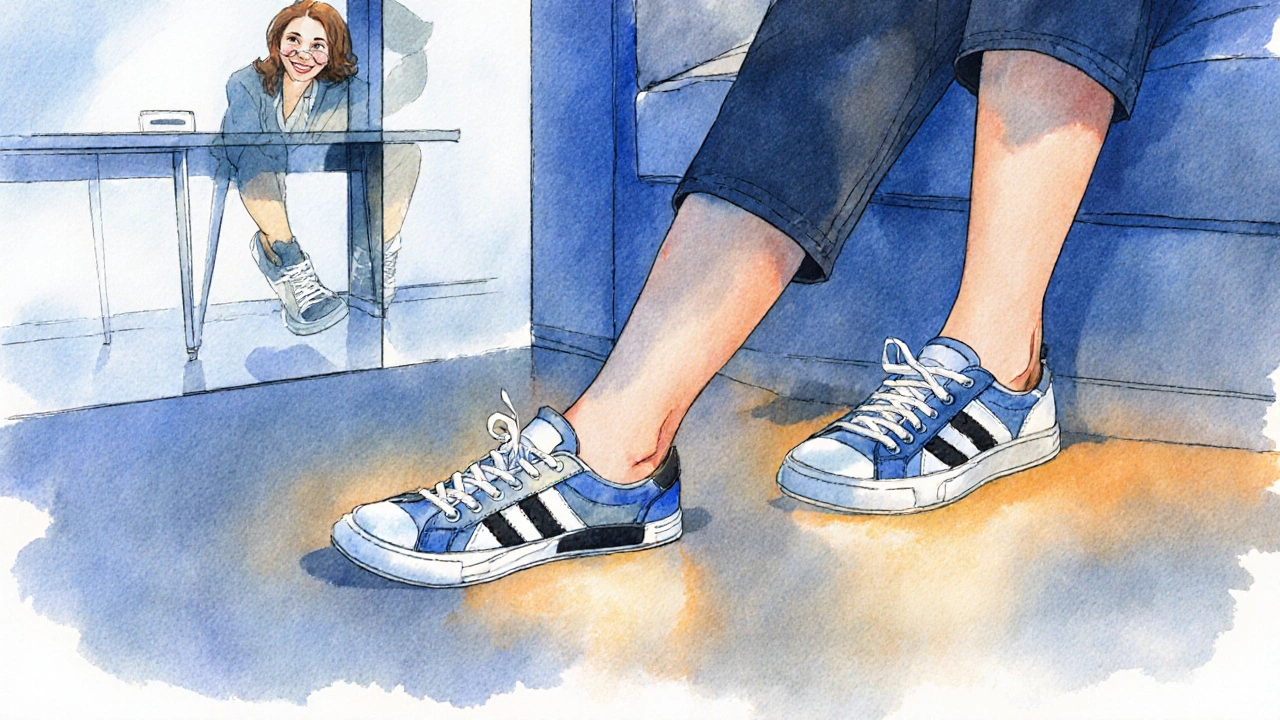Shoe Width Calculator
Measure Your Feet
Enter your foot measurement in millimeters (mm)
Results
Enter your measurements to see your width recommendation
Ever stare at a shoe label that says shoe width the measurement that tells how wide a shoe’s toe box is, ranging from narrow to extra‑wide and wonder whether you’re an AD or an EE? You’re not alone. Many shoppers confuse these letters, end up with tight or loose fits, and waste time (and money). This guide walks you through exactly how to tell which width you need, why it matters, and how to avoid the common sizing traps.
Key Takeaways
- AD usually means a standard or medium width for most brands, while EE indicates an extra‑wide foot.
- Accurate measurement requires a Brannock device or a simple ruler‑and‑paper method.
- Compare your foot’s foot length and foot width against the brand’s size chart.
- When in doubt, try on shoes at the end of the day; feet swell after hours of activity.
- Use our AD vs EE checklist to pick the right pair every time.
Understanding Shoe Width Labels
Brands use letters to signal width. The most common system (especially in the U.S.) looks like this:
- B - Narrow (women)
- D - Standard/Medium (men)
- AD - Often marketed as “Average” or “Standard” for unisex lines; essentially a medium width.
- EE - Extra‑wide, suitable for people with a wider forefoot or high volume.
- 2E, 3E, 4E - Progressive extra‑wide sizes used by performance and work‑boot brands.
While the letters differ, the principle stays the same: they describe the distance across the foot at the metatarsal heads (the ball of the foot).
How to Measure Your Foot Accurately
Getting the right width starts with a proper measurement. Here are two reliable methods.
1. Using a Brannock Device
The Brannock device a calibrated measuring tool found in most shoe stores that records foot length, width, and arch length is the gold standard. Follow these steps:
- Stand on a firm surface and place the device under your foot.
- Align the heel piece with the back of your heel.
- Slide the sliding bar until it snugly contacts the outside edge of your longest toe.
- Read the width marker where the bar meets the width scale; it will show a letter such as B, D, AD, or EE.
If you don’t have a Brannock device, many shoe stores will measure you for free.
2. DIY Ruler‑and‑Paper Method
When you’re at home, use a plain sheet of paper, a pencil, and a ruler.
- Place the paper on a flat floor and stand on it, ensuring your weight is evenly distributed.
- Trace the outline of your foot with the pencil, keeping the pen upright.
- Measure the distance across the widest part of the outline - usually just behind the toes.
- Convert that measurement to the nearest width letter using the chart below.

AD vs EE: The Comparison Table
| Attribute | AD Width | EE Width |
|---|---|---|
| Typical foot width range (in mm) | 96-101 | 106-111 |
| Most common foot shape | Average forefoot, neutral arch | Wider forefoot, sometimes flat arch |
| Brands that frequently offer EE | Most fashion brands (e.g., Converse, Vans) default to AD | Work‑boot and outdoor brands (e.g., Timberland, Keen) |
| Recommended for | People whose foot width measures < 100mm | People whose foot width measures ≥106mm |
| Fit feel | Snug around the ball, less material | Roomier, less pressure on the sides |
When to Choose EE Over AD
Even if your measurement sits near the boundary, consider these real‑world signs that EE might be the better choice:
- You feel pressure or pinching on the sides of your shoes after a short walk.
- Blisters appear around the metatarsal heads during runs or hikes.
- You have a naturally wide foot shape-often visible when you look at the side‑by‑side photo of both feet.
- Your shoe brand’s size chart lists a narrower width for the same foot length.
Common Pitfalls and How to Avoid Them
Many shoppers make avoidable mistakes that lead to an incorrect width decision.
- Measuring only one foot. Feet are rarely identical; always measure the larger foot.
- Measuring at the wrong time of day. Feet swell after activity, so measure in the afternoon or evening for a realistic fit.
- Relying on brand‑specific sizing without checking the chart. A size 10 in Brand A could be wider than a size 10 in Brand B.
- Ignoring the arch type. High arches often require more volume; a wide width can compensate even if the foot isn’t technically wide.
- Trying on shoes with thick socks. Sock thickness adds up to 2mm, which can push a borderline foot into the next width.

AD/EE Checklist - Quick Decision Tool
- Measure both feet with a Brannock device or ruler method.
- Note the width reading (e.g., AD, EE).
- Cross‑reference the reading with the brand’s size chart.
- Check for side pressure after a short walk in the store.
- If any sign of tightness appears, step up to EE.
- Buy from retailers with a flexible return policy in case the fit feels off at home.
Putting It All Together - Real‑World Example
Meet Maya, a 28‑year‑old graphic designer who loves sneakers. She measured her right foot using a Brannock device and got an AD width, while her left foot read EE. Maya’s brand (a popular street‑wear label) only offers AD for her size. She tried the AD pair and felt a subtle squeeze at the ball after a two‑hour workday. Applying the checklist, she opted for a custom‑ordered EE version from a boutique that offered a wider toe box. The result? No blisters, comfortable all‑day wear, and a longer shoe lifespan.
Maya’s story illustrates why paying attention to both feet and listening to your body matters more than trusting a single label.
Frequently Asked Questions
What does AD stand for on a shoe label?
AD is a brand‑specific way of indicating a standard or medium width. It’s equivalent to a D width for men or B width for women in most sizing systems.
How wide is an EE shoe compared to a regular D?
EE typically adds about 5‑7mm to the forefoot measurement. If a D width is around 95mm, EE will be roughly 101‑107mm, providing noticeable extra room.
Can I wear EE shoes if I’m a narrow‑footed runner?
Generally no. Running shoes need a snug fit to prevent slippage. If you have a narrow foot, stick with AD or even narrower widths (B). Wide shoes can cause blisters due to excess movement.
Do all brands use the same width letters?
Most U.S. brands follow the standard B‑D‑EE system, but some international or fashion‑forward labels use their own codes (e.g., AD, M, W). Always check the specific brand’s width chart.
Is it okay to buy shoes online without measuring my width?
It’s risky. If you can’t measure, at least know your foot’s width range from a recent in‑store visit and rely on brands with generous return policies. Some sites also let you upload a photo of your foot to get a recommendation.
